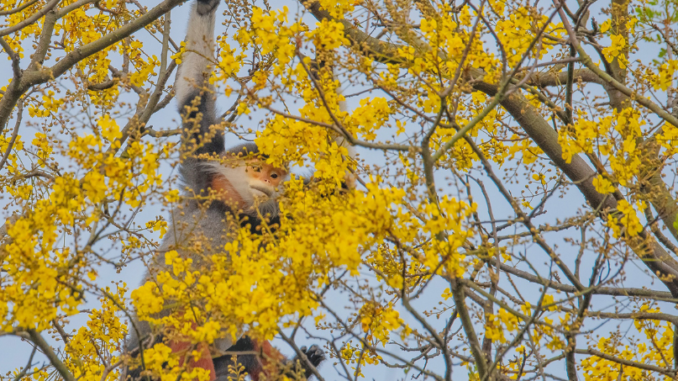
DA NANG – Son Tra glows in the blooming season, attracting brown-shanked langurs to pass their branches to eat.

Son Tra peninsula, near Tien Sa cape is home to a row of perennial limestone trees, each tree with an average height of 9 -10 m. In April, when the flowers bloom, the corner of the forest looks like it’s dyed gold, blooming under the blue sky.
Limestone is a tree, often grown to create urban landscapes, mainly in the Central and Southern regions.

This is also an opportunity for nature-loving photographers to “hunt for photos”. The concrete area on the mountain with a wire ladder designed specifically for langurs to move through is an attraction for photographers.

Group of photographers Vo Rin, Ha Vu Linh and Nguyen Thuy Linh arrived here at 3pm on April 7. An hour later, a herd of 9 langurs appeared, they ate yellow flower buds and in turn moved across the rope ladder. The photo above by author Nguyen Thuy Linh (1991) made.

Son Tra peninsula has a diverse forest ecosystem, with nearly 1,000 plant species, including 22 rare and precious plant species. This is also home to hundreds of animals, especially the brown-shanked douc.

Ha Vu Linh (born in 1993) said that he was impressed by Son Tra’s natural beauty, with yellow flowers blooming in the sun and when the langurs moved across the rope ladder like a circus artist. Son Tra langurs seem accustomed to human appearance, however, they are still vigilant.

Jump passing branches of Son Tra brown-shanked douc.

Photographer Vo Rin (born in 1983) said that early morning and late afternoon are the two most suitable time to take pictures of langurs.
The brown-shanked douc is also known as the “primate queen” due to its colorful coat of yellow, brown or reddish brown, orange, gray, black and white. The top of the head near the forehead has a black flap, the face is light yellow and the legs are reddish brown, the adult male is about 55 – 63 cm long, the adult female is 50 – 57cm long.

Studies and surveys to identify the brown-shanked douc langur are only distributed along the Annamite range, in the forest areas bordering the south of Laos and central Vietnam, in addition to a small part of northeastern Cambodia.
The brown-shanked douc is a rare and endemic species in Vietnam. The World Conservation Union (WWF) places them on the list of animals that need to be unconditionally protected.

Currently, hundreds of species of douc langur are strictly preserved by the local authorities.
Follow vnexpress
Yellow flowers blossoming “numb” tourists’ feet on Son Tra peninsula
The yellow color of the limestone flower makes a corner of Son Tra peninsula (Da Nang city) stand out. Trees grow along the winding mountain road with a bright golden canopy holding visitors when visiting here.

In the summer, Son Tra peninsula becomes dazzling thanks to the colorful flowers. The vibrant yellow petals alternating between the green leaves become the highlight to attract visitors to visit.

From the center of Da Nang, follow Yet Kieu Street to near Tien Sa port area, visitors move on a steep road winding around the cliffs leading up to Son Tra. Only about 2km away, visitors will easily see the outstanding yellow color of the limestone.
The flowers grow perennial, about ten meters high, cluster in the heart of Son Tra peninsula, at the tip of Tien Sa.

From the end of March, red flowers (also known as yellow chrysanthemums, golden phoenix flowers, golden phoenixes, limestone flowers …) began to bloom brilliantly on Son Tra peninsula.
In Son Tra peninsula, the limestone tree is home to the rare brown-shanked douc. If you are lucky, you can see the langurs swinging on the limestone branches.

The best time to watch flowers and langurs is early in the morning and in the cool afternoon. This is the time when langurs rub their brown legs, and other animals come to feed on the tall canopy.

Mr. Pham Van Phung (Hai Chau district) – a photography enthusiast said that a year in Son Tra peninsula only has a fluttering season, because the world of photography everyone wants to “hunt” a picture of langurs. foraging under the bright yellow flowers.
“This is a wonderful scene and very much to be expected. Therefore, this time of year, many motorists and tourists are coming here a lot. A few days ago, people came back to take pictures of langurs and red flowers. Some people from Hanoi and Ho Chi Minh City also came to take pictures “- Mr. Phung shared. Follow Dân trí
